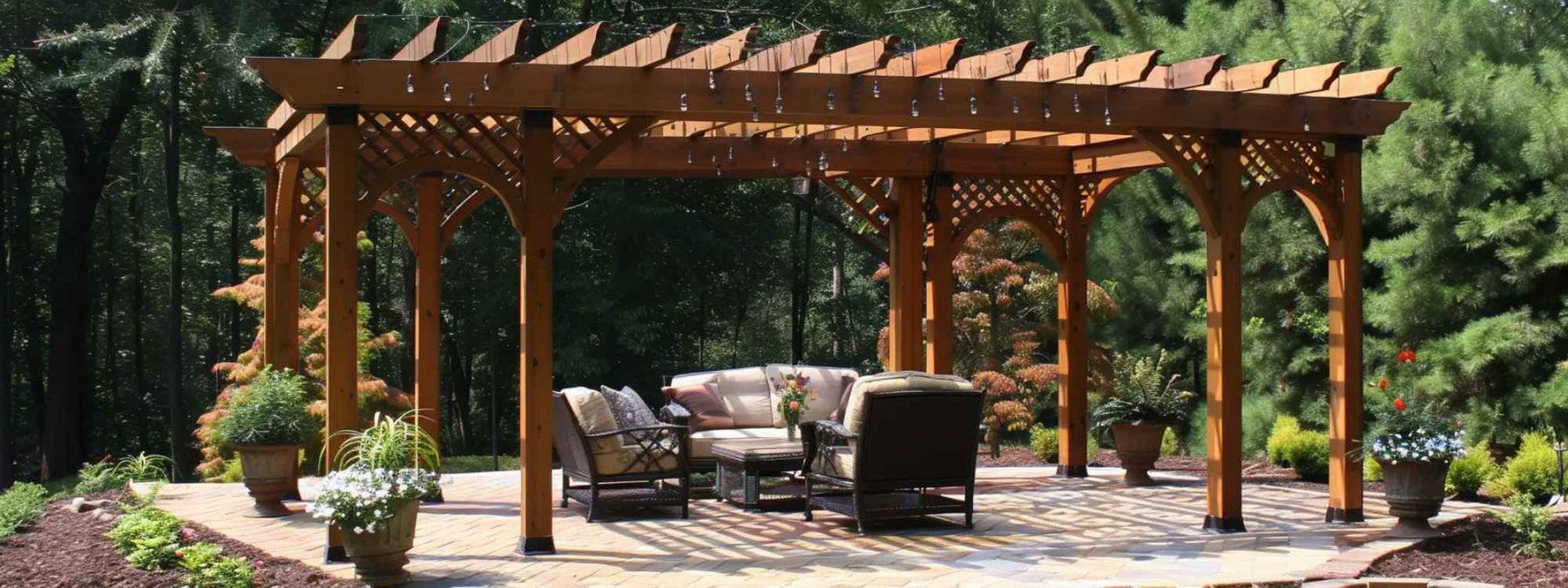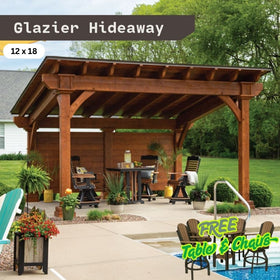512-777-0154

How to Maintain a Wooden Pergola?
A wooden pergola can make your outdoor space feel like a retreat. It adds structure, shade, and a little character to your yard. But here’s the thing—wood doesn’t take care of itself.
If it’s been a while since you gave yours a proper once-over, now’s a good time to ask: When’s the last time you looked up and checked its condition?
Is it still giving you filtered sunshine and clean lines? Or are you seeing splinters, faded wood, and maybe some unexpected greenery?
It’s easy to forget about it until something starts falling apart. The good news? Taking care of a wooden pergola doesn’t have to be a huge project.
With a few basic steps and a little consistency, you can keep it looking sharp and standing strong for years.
Step 1 – Start With a Quick Visual Check
Before you break out the tools or buy anything, just take a slow walk around your Brookside Timber Frame Shadelan Retreat Pergola. A quick visual check can save you time and money later.
Here’s what to look for:
- Cracks or splits in the wood, especially near joints.
- Warping or sagging beams that don’t sit like they used to.
- Rusty screws or loose fasteners that might need tightening or replacing.
- Mold, mildew, or algae, especially in damp or shaded areas.
Don’t forget to look up. Sometimes, damage hides in plain sight.
Step 2 – Give It a Good Cleaning

Your pergola spends its life outdoors. Rain, dust, pollen, bird droppings—you name it. Over time, all this builds up, making your once-bright pergola look dull.
It’s tempting to skip cleaning, thinking rain will do the job. It won’t. But how to maintain a pergola?
Use the Right Cleaning Solution
You might think any soap works, but let’s pause here.
Regular dish soap mixed with water is gentle enough for most wooden pergolas. It lifts dirt without harming the wood.
But if your pergola looks rough, you may need something stronger for your pergola maintenance—a dedicated wood cleaner. Wood cleaners break down grime effectively, prepping your pergola nicely if you're thinking of staining or sealing it soon.
Got mold or mildew creeping in? Consider using a mild bleach solution or vinegar diluted in water. Both are great at tackling stubborn spots.
A quick caution: don’t reach for harsh chemicals or a pressure washer. These might seem convenient, but they can seriously damage the wood, leaving it fuzzy or splintered. Keep it gentle.
Scrub It Down, Rinse It Off
Grab a soft-bristle brush and your garden hose. That’s all you need.
Work methodically, section by section. Start at the top and move downwards. Scrub gently—this isn’t about force; it's about consistency.
Once you've loosened the dirt, rinse thoroughly but don’t soak the wood. Excessive water means longer drying times and potential damage.
Let your pergola dry completely before you move on to sanding or sealing.
Step 3 – Time to Sand and Smooth the Surface
Once your pergola is clean and dry, it's time to deal with the rough stuff.
Sanding might sound optional, but it makes a big difference. It smooths out splinters, evens the surface, and helps stain or sealant stick better. Skipping it? You’ll probably notice.
Start by checking the surface for trouble spots. Look for:
- Rough patches where the wood feels uneven.
- Edges and corners that tend to fray over time.
- High-touch areas, like posts or railings, where hands tend to land.
If you're using sandpaper, aim for medium grit—around 80–120. Got a power sander? Even better. Orbital sanders save time and deliver more consistent results.
Don’t go overboard. A light pass is usually enough unless the wood is in really bad shape.
And don’t forget safety. A dust mask and gloves are smart to wear. You’re not sanding a dining table here, but you still don’t want to breathe in fine particles.
Take your time.
Step 4 – Reseal or Stain It
Once the surface is clean and smooth, it’s time to protect the wood. This is the part that keeps your Brookside Timber Frame Highland Oasis Pergola from drying out, fading, or turning gray and splintery over time.
It’s not just about looks—sealing or staining helps the structure last longer. And while it sounds like a big job, it’s not bad if you plan it right.
How Often Should You Reseal or Restain?
Short answer: every 1 to 3 years.
If you live somewhere with intense sun or dry weather, aim for the shorter end. Shade and mild climates buy you more time.
Not sure when it’s due? Splash a little water on the wood. If it soaks in instead of beading up, the old sealant isn’t doing much anymore.
Choosing the Right Sealant or Stain
- Sealers protect the wood without changing the color.
- Stains protect and tint the wood, giving it a richer look.
Oil-based products last longer but take more time to dry. Water-based ones are easier to clean up but may need more frequent touch-ups.
As for the finish? That’s personal. You can go matte for a natural look or semi-gloss if you want a bit more shine.
How to Apply It Without Making a Mess
Start with a clean, completely dry surface. (Step 2 has you covered.)
Then:
- Use a brush, roller, or sprayer.
- Apply thin, even coats—don’t rush it.
- Let it dry fully, as directed on the label.
- And yes, check the forecast. You don’t want to race the rain or seal wood in high humidity.
Done right, this step gives your pergola a fresh layer of defense—and a solid glow-up while you're at it.
Step 5 – Keep an Eye Out for Pests

Brookside Timber Frame Zion Resort Pergola might look great to you, but unfortunately, termites and carpenter ants might see it as lunch.
So, what should you watch out for?
Check regularly for tiny holes or little piles of sawdust—sure signs something is making itself comfortable inside the wood. If tapping lightly on your pergola sounds hollow, that's another red flag. Solid wood shouldn't sound empty.
Prevention isn't complicated:
- Keep mulch, plants, or stacks of firewood away from the pergola. Moist areas attract pests.
- Consider treating the wood with a pest-repelling sealant to make it less appealing.
And if you do find something suspicious, don’t hesitate to call a professional. DIY is great, but tackling termites yourself can quickly escalate.
Step 6 – Do Seasonal Touch-Ups and Small Repairs
Big repairs usually start as small annoyances you keep ignoring. Your Brookside Timber Frame Timber Resort Pergola is no exception.
Instead of waiting for a major overhaul, try making smaller repairs as part of your routine. It saves you hassle down the line and keeps things manageable.
Check screws and bolts each season. Weather and wood shifts can loosen them up. Tightening takes five minutes and prevents bigger headaches later.
See a cracked or warped board? Swap it out now instead of waiting for it to break completely. Trust me—boards don't magically heal themselves.
And those faded spots? Don’t wait until your entire pergola screams for a fresh coat. Grab a brush and touch up problem areas as they appear. You’ll extend the life of your stain or sealant and keep everything looking consistent.
A Few Hours a Year, and Your Pergola Will Last for Decades
Maintaining wooden pergolas doesn’t require a full toolbox or a weekend-long project every season. Just a few hours a year can go a long way.
Check it. Clean it. Fix what needs fixing.
That’s really it.
Regular upkeep is easier—and way cheaper—than replacing the whole thing because of neglect. It’s not about keeping it perfect. It’s about keeping it strong and looking good.
You don’t need to be a carpenter. Just someone who cares about keeping your outdoor space in shape.
Want more practical guides like this? Check out our other blogs for outdoor kitchen tips, seasonal maintenance ideas, and ways to make the most of your space.







